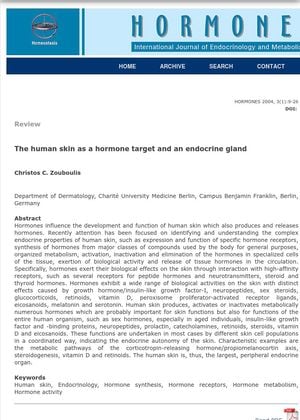The Human Skin as a Hormone Target and an Endocrine Gland
January 2004
in “
Hormones
”
androgens testosterone 5a-dihydrotestosterone 5a-DHT ACTH anagen phase IGF-I sebocyte proliferation hair follicle growth PTHrP CRH urocortin POMC peptides prolactin catecholamines steroid hormones retinoids vitamin D eicosanoids DHT insulin-like growth factor 1 adrenocorticotropic hormone parathyroid hormone-related protein corticotropin-releasing hormone pro-opiomelanocortin peptides

TLDR Human skin acts like a hormone-producing organ, making and managing various hormones important for skin and hair health.
The 2004 study "The human skin as a hormone target and an endocrine gland" concluded that human skin is the largest peripheral endocrine organ. The research found that skin cells produce, release, activate, inactivate, and eliminate hormones, interacting with high-affinity receptors for various hormones. The skin also converts circulating androgens into testosterone and 5a-dihydrotestosterone (5a-DHT). The study also detailed the role of various hormones and compounds in skin and hair health. For instance, overproduction of ACTH may prolong the anagen phase of the hair cycle, and IGF-I significantly stimulates sebocyte proliferation and is essential for hair follicle growth. The document also discussed the synthesis of hormones in the skin, including PTHrP, CRH and urocortin, POMC peptides, prolactin, catecholamines, IGF-I, steroid hormones, retinoids, vitamin D, and eicosanoids. The skin's ability to activate or inactivate these hormones was also discussed.




